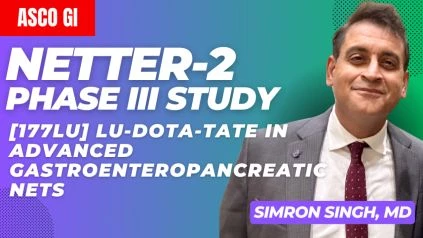Simron Singh, MD: [00:00:00] So radioligand therapy is like in a new emerging treatment for cancer. where we try to inject radioactive isotopes through the body that bind to the cancer receptors and are taken up by the cancer cells and then the cancer cells are killed, but generally preserve healthy tissue. So the NETTER-2 clinical trial is the first clinical trial to date that examines this type of therapy as the first line therapy in any cancer.
And so specifically with the NETTER-2 trial, we looked at advanced Grade two and grade three neuroendocrine cancers from the G. I. Tracked on compared them to receiving high dose somatostatin analogs versus radio ligand therapy.
OncologyTube: All right. Could you explain the significance of the net or two studies?
Findings? As a first line treatment for patients with grade 2 and grade 3 advanced gap net [00:01:00] neuroendocrine tumors, particularly in the context of an unmet medical need for this patient population.
Simron Singh, MD: Yeah, no, it’s a good question. This patient population has just been recently defined and We don’t have any data to say what the right treatment is for these sorts of patients.
As you can imagine for a patient, that’s very scary to be diagnosed with a treatment and to hear that there’s no treatments that we know are the best available ones. So this study is the first one to define. the best treatment for these high grade, well differentiated neuroendocrine cancers. The results were quite good, I have to say.
It showed a 72 percent risk of reduction of progression or death in those patients who had received the PRRT versus those patients who received the high dose octreotide. Oh,
OncologyTube: okay. Can you provide insights into the safety profile of the study compared to the high dose octreotide, LAR, especially concerning adverse events of special interest related to radioligand therapy?
Yeah, no, it’s
Simron Singh, MD: [00:02:00] really a question. The adverse events were as expected, but the real question, as you alluded to, is, what are the rates of MDS? Or disorders of the bone marrow with radioligand therapy, which is a known side effect. On the trial, we only had one patient, unfortunately, who developed that that complication, but it’s still early, and we’ll have to continue following the data to see what the ratio, the number of patients who developed that toxicity.
It’s a very important part of the discussion with patients.
OncologyTube: Excellent. Given that this study represents the first randomized trial demonstrating the efficacy of RLT as a first line treatment in any malignancy, what are the potential implications for the broader field of oncology and what further investigations or applications of RLT do you foresee in other clinical settings?
Simron Singh, MD: RLT, or radial ligand therapy, is a brand new way of treating cancer. Traditionally, we’ve had three ways of treating cancer. Chemotherapy or targeted therapy. Radiation and surgery. This opens. It’s a new frontier. I would say in how we treat cancer. It’s a new [00:03:00] mode of treating cancer. I think the fact that we now have a trial showing that it has been used first line before any other treatments is very exciting.
And I think our lt is growing rapidly and it’s being investigated a number of other cancers. So that’s very exciting. I think the other thing we want to understand is what people who have had this treatment, can they get more of it? I think those trials as well are going to be very important. Yeah.
OncologyTube: All right, great.
So as far as this trial is concerned, so what are the key takeaways for the oncologist? The G. I. S. Out there? What? What? What
Simron Singh, MD: should be? I think the big thing to know is that this is the first trial that shows us what to do in high grade neuroendocrine tumors. It is a new option for patients and their doctors to discuss and determine if it’s right for them.
And it’s certainly it works. Like I said, it shows a 72 percent reduction in risk of progression or death in those patients who have been diagnosed with this more aggressive form of neuroendocrine cancer.
OncologyTube: Fantastic. This has been Dr. Simran Singh, Medical Doctor, Associate Professor at the University of Toronto and the Sunnybrook [00:04:00] Research Institute in Canada.
Dr. Singh, thank you so much for chatting with us today. Thank
Simron Singh, MD: you.

